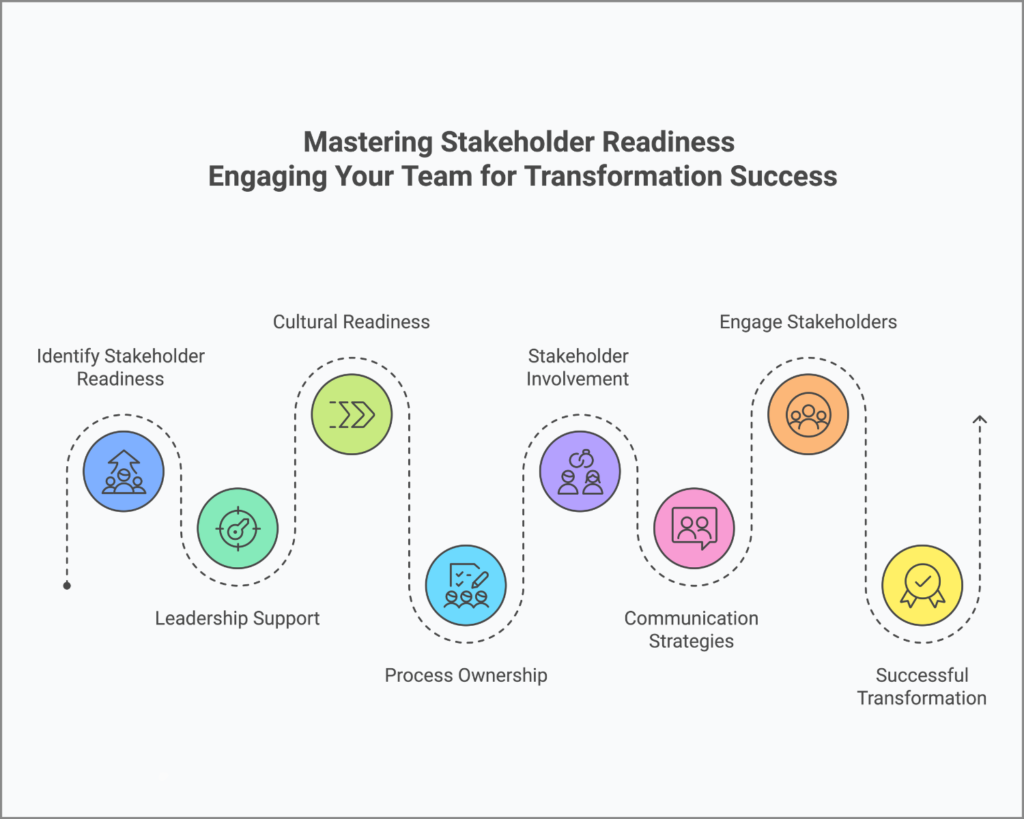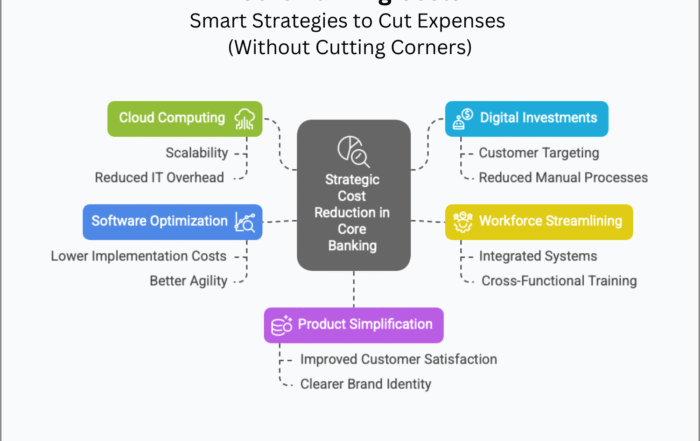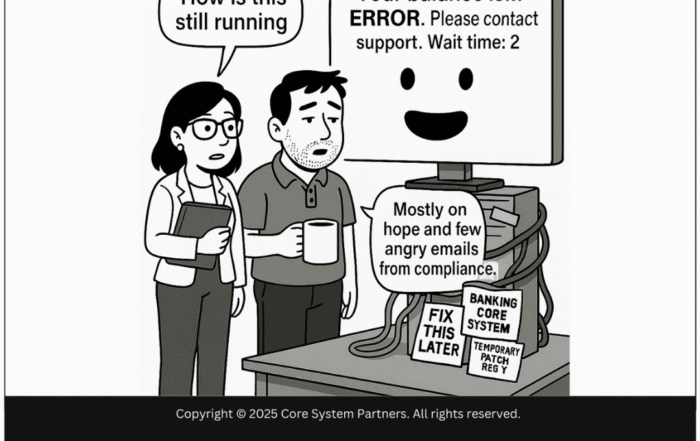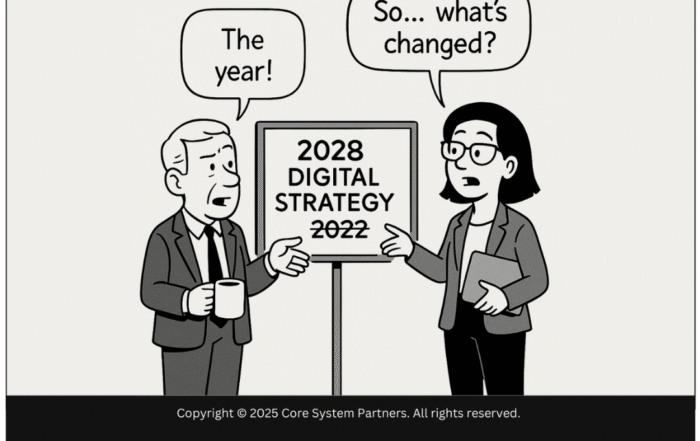
Stakeholder readiness is key to successful core banking transformations—engage, align, and empower your team for lasting success.
The article “Mastering Stakeholder Readiness: Engaging Your Team for Transformation Success” provides strategies to effectively prepare and involve your team in organizational change initiatives.
TL;DR – Mastering Stakeholder Readiness: Engaging Your Team for Transformation Success
- Simplify Workflows – Streamline processes to enhance efficiency and reduce complexity.
- Clarify Roles – Define clear responsibilities to ensure accountability and smooth collaboration.
- Boost Productivity – Implement strategies that empower your team to perform optimally during transitions.
- Foster Engagement – Encourage active participation and buy-in from all stakeholders to drive successful transformation.
By focusing on these areas, organizations can effectively engage their teams and achieve successful transformation outcomes.
Ever start a journey and then discover that only some were on the bus? That’s how core banking transformation projects often are. I once worked with a mid-size bank that had it all: the best technology, a great team, and what was a brilliant plan. But the more the project went on, the more it fell apart. As might be expected, confusion and some resistance to the shift from set employees set in, and the project began to slip behind schedule. What wasn’t there? Readiness of the stakeholders.
What this means is that much more than a green light from top management, it is the understanding and support of all who can be touched by the transformation that is on the journey- either back-office, customer-facing, or a third-party partner. The rest of this article will explain in detail why stakeholder readiness is important and give an overview of steps to take to ensure your team will embrace the change.
Understanding the Readiness of Stakeholders
What, then, is stakeholder readiness? In plain words, it is the art of gauging how ready all persons are the man or group dealing with and supporting this change. That means everything: from your C-suite leaders to the last employee level, customers, partners, and regulators. It is all about lining up all minds and hearts to the purpose of the transformation.
Just like trying to sail the boat through stormy seas with a crew in doubt of which direction to go or even of their contribution towards its achievement. Without stakeholder readiness, you will soon find yourself incessantly caught in a host of troubles that might be summed up below:
- Resistance to Change: Personnel would resist this new system and its processes, which would slow them down and make them easily frustrated.
- Misalignment: In the absence of the big picture, many pull in different directions.
- Low Morale: Lack of communication creates uncertainty that crushes trust and morale.
Whereas in stakeholder engagement and alignment:
- Seamless Transitions: Adaptation of the change with less disruption occurs.
- Buy-in: One is on board and committed to the achievement of success.
- Better Outcomes: One is on board and committed to achieving success.
Critical Enablers of Stakeholder Readiness
Knowing why it is so important, let’s have a closer look at the key enablers supporting stakeholder readiness:
1. Leadership Support
Leadership sets the beat for the entire enterprise; active and visibly committed leaders indicate to the rest of the organization that this is a severe transformation effort in ways such as:
- Setting a Clear Vision: They should also articulate the “why” for the change and the benefit that will result.
- Resource Commitment: It means the commitment of proper resources required, which involves time, budget, and people.
- Role Modeling: The leaders must be flexible towards the modification themselves and act as role models, showing eagerness about the change.
2. Cultural Readiness
How ready is your organization’s culture to manage this change? An elastic culture innovates, and any proposed change has little or no resistance.
- Think out of the box at work: let employees share their innovative ideas.
- Attitude toward learning: A person considers mistakes to be learning curves, never failures.
- Empowerment: Employees are given the right to decide about jobs.
3. Process Ownership and Governance
Everybody has to know their role in transformation.
- Define Responsibilities: Clearly define process and task ownership.
- Take Care of Governance Structures: Establish committees or boards to oversee the transformation.
- Align with Objectives: The governance structure must align with the objectives.
4. Stakeholder Involvement
This, therefore, calls for early and repeated involvement of stakeholders.
- Inclusive Planning: Plan inclusively to take into consideration several viewpoints.
- Feedback Mechanisms: Avail avenues for feedback and discussion.
- Address Concerns: Attend to the concerns and reservations; speak to them candidly.
5. Communication Strategies
It requires complete transparency and regularity of communication.
- Clear message: The story builds on what, why, and how.
- There are plenty of channels: by email, through meetings and newsletters, and via the intranet.
- Two-way Communication: Stimulate questions and respond promptly.
Best Practices in Engaging Stakeholders
Now, how do you prepare and engage your stakeholders effectively? The following are strategies that have proved effective:
1. Paint a Seductive Vision
Tell a story that relates the change to the organization’s mission and values. Highlight that this change will benefit the company, employees, and customers. Make this relevant and motivational.
2. Lead by Example
The leadership’s involvement in transformation activities and training, coupled with discussion, will motivate their employees to embrace change even more.
3. Empower Your Team
Give teams ownership for particular areas of the transformation. Often, people are motivated by having a vested interest in its success.
4. Facilitate Open Dialogue
Set up discussion boards where all stakeholders are free to pose questions, air their grievances, and give feedback that one must listen to. This way, other vital proposals can proceed, and more buy-in will be created.
5. Training and Support
Equip the team with knowledge and competencies to use the new system or process. Generally, people feel more confident when they’re competent, and training develops both elements.
6. Recognize and Celebrate Milestones
Allow yourself to take time and celebrate whether a pilot who worked training completed or any milestone in the project. These recognitions boost morale and reinforce the value of the transformation.
Success Impact on Transformation
Where the stakeholders are prepared and committed, the transformation has a better probability of sticking to timelines and realizing some benefits anticipated. You will discover that:
- Greater Tech-acceptance: More employees accept new technologies and processes.
- Improvement in Quality: Innovative problem solving because of the collaborative environment.
- There is the minimization of risk: Early open communication identifies potential problems, facilitating solution-finding.
In contrast, poor readiness among stakeholders has more often resulted in project delays and even complete failures.
Moving Forward
Remember the mid-sized bank we talked about earlier? They took a step back and created a comprehensive stakeholder engagement plan. They turned resistance into enthusiasm by involving employees at all levels, establishing open communication channels, and providing support. Not only did the project get back on track, but it also exceeded its initial goals—leading to improved customer satisfaction and operational efficiency.
Your organization can achieve similar success by prioritizing stakeholder readiness. Remember that transformations aren’t just about implementing new technology or processes but also about people.
Your Next Steps
Are you ready to assess your organization’s stakeholder readiness? Our Core Banking Transformation Readiness Assessment is a great tool to identify strengths and areas for improvement.
Click here to access the scorecard and start your journey toward a successful transformation today. With the proper preparation, you can navigate complexities, overcome resistance, and position your organization for long-term success.
Found this article interesting? Check out these three related reads for more.
- The Ultimate Guide to Core Banking Transformation Readiness
- Optimizing Strategy Alignment: Ensuring Your Transformation Drives Business Goals
- Fostering Innovation and Agility: Staying Ahead in a Rapidly Changing Market
#CoreBankingTransformation #CoreBankingReadiness





